Family : Bovidae

Texte © Dr. Lucrezia Callocchia

English translation by Mario Beltramini
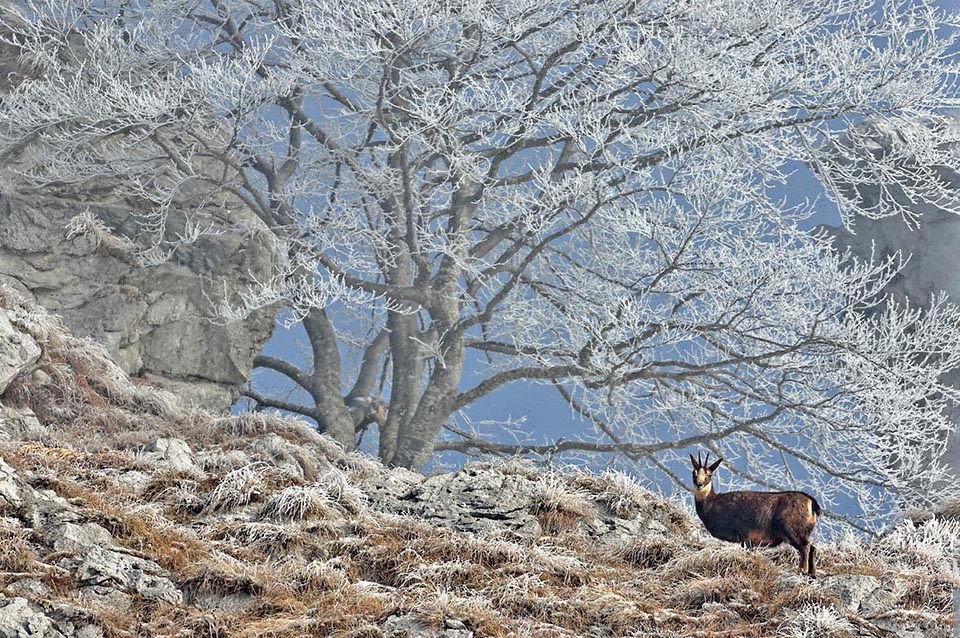
The Alpine chamois (Rupicapra rupicapra) is frequent in Europe on the Alps and with 5 subspecies on the mountain reliefs of Asia Minor, Balkan Peninsula, Carpathians, Chartreuse Prealps, in France, and on the Tatra mounts, on Poland-Slovakia border, that mark the northern limit of distribution for this species © Cesare Giussani
The Alpine chamois, Rupicapra rupicapra (Linnaeus, 1758), is a mammal belonging to the order Artiodactyla (from the Greek artios even and dactylos finger), to the family Bovidae and to the subfamily of the Caprinae, that is medium size ungulates, skilled climbers and well suited to mountain environments.
The term “chamois” comes from the late Latin camox -ōcis and refers to the camouflaging skills of this animal and to its capacities of “disguising” in its environment; on the other hand, the scientific name “rubicapra” comes from the classical Latin “rupes” = rock and “capra” = goat and reminds the strong relation of the chamois with the rock environments.
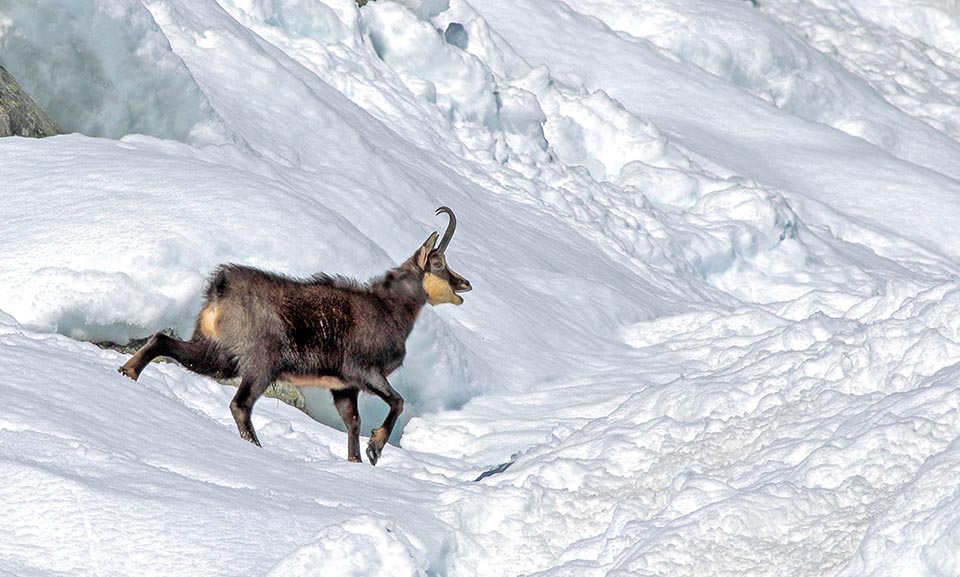
The dark winter fur that absorbs the sun rays and the fat reserves shelter it from cold. The interdigital membrane grants an agile gait even on fresh snow © Giorgio Pilla
The genus Rupicapra is represented, as well as by the alpine species, also by the so-called Pyrenean chamois, Rupicapra pyrenaica, slightly smaller, that includes the subspecies Rupicapra pyrenaica ornata, endemic to the central Apennines.
Zoogeography
To the species Rupicapra rupicapra are attributed several subspecies whose determination is based on small morphological differences and on the distributions, however the taxonomic validity of these divisions is not sure and is often subject of discussions among the experts.
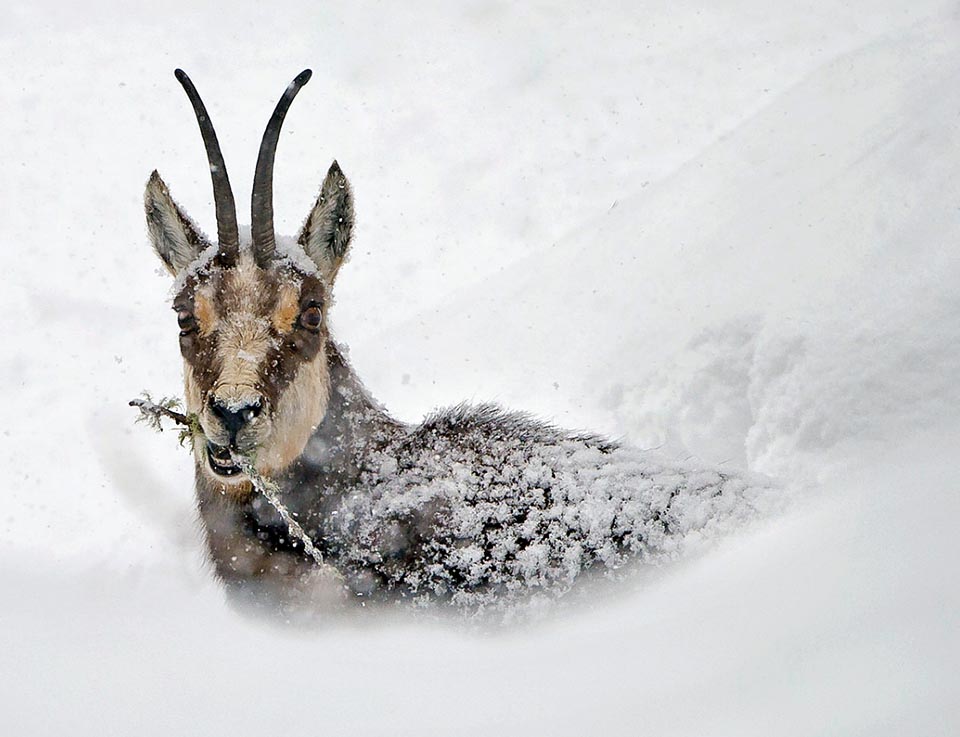
In the blizzard when there is nothing to graze, even a sprig full of lichens can be good © Roberto Vallet
The subspecies presently recognized are the following:
Rupicapra rupicapra rupicapra, diffused on the Alps.
Rupicapra rupicapra asiatica, diffused in Asia Minor, on the nort-eastern mountains of the Black Sea, in the eastern zones of Turkey and in thesouth-western regions of Georgia; it is smaller and its summer fur is paler.
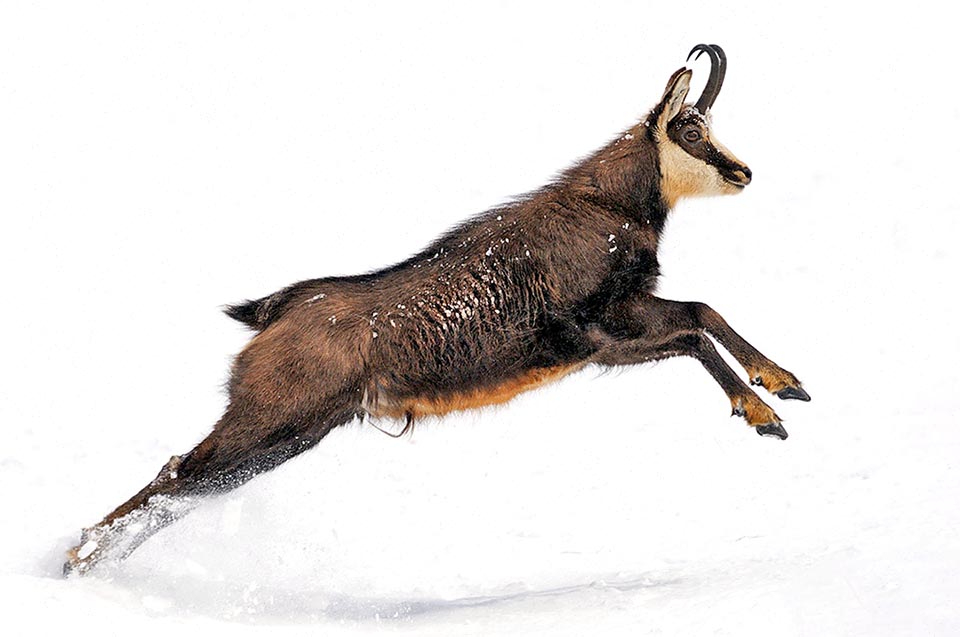
The even 140 cm long with a wither’s height of 80 cm males after a good grazing season by the end of October can reach even the 45 kg © Alberto Olivero
Rupicapra rupicapra balcanica, diffused in the mountain zones of the Balkan Peninsula, probably little bigger than the Alpine chamois, with longer horns and more brownish fur in summer and dark with yellowish shades in winter.
Rupicapra rupicapra carpatica, diffused on the Carpathians, seems to be bigger, longer horns and darker fur in summer as well as in winter.
Rupicapra rupicapra cartusiana, with a very limited range on the Chartreuse (France) Pre-Alps; has above average dimensions and winter hair tending to black.
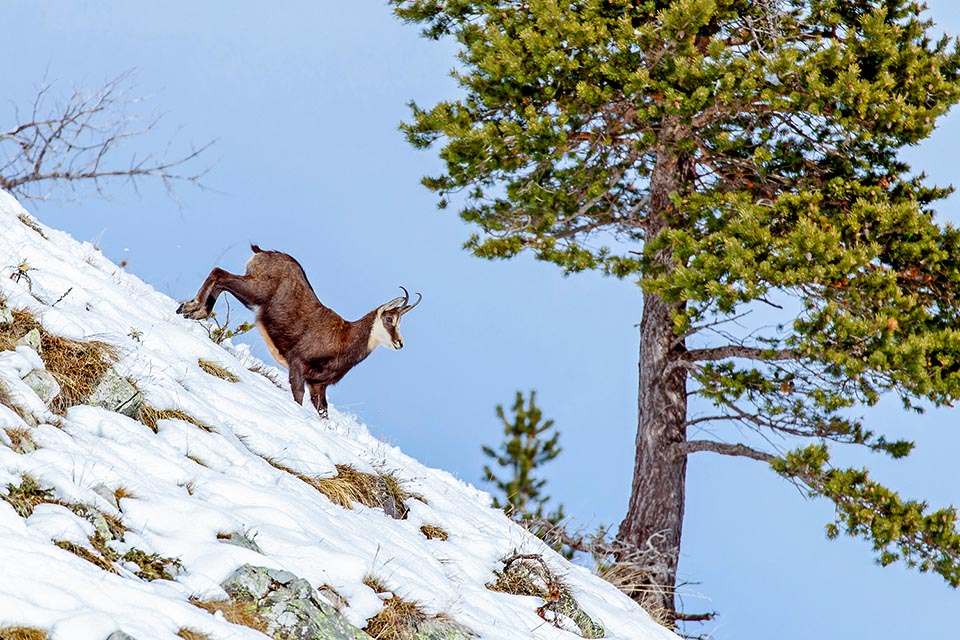
The habitat extends on three altitudinal lines: the mountain one, with conifers and broad-leaved forests rich of underwood, spaced by rocky walls, gorges and clearings; the sub-alpine with scattered larch, mountain pine and bushes and the alpine marked by prairies, dwarf shrubs and rocky zones up to the snow horizon line of 2600-3000 m © Claude Tacco
Rupicapra rupicapra tatrica, present on the Tatra Mountains, on the border between Poland and Slovakia, represents the northernmost distribution limit of the species. The fossil remnants place the zoogeographic origin of this genus in south-western Asia, in the Miocene, and suggest a diffusion towards west during the Middle-lower Pleistocene.
Nowadays, the Alpine chamois is distributed with different densities, in the major mountain systems of central-southern Europe and of Asia Minor.
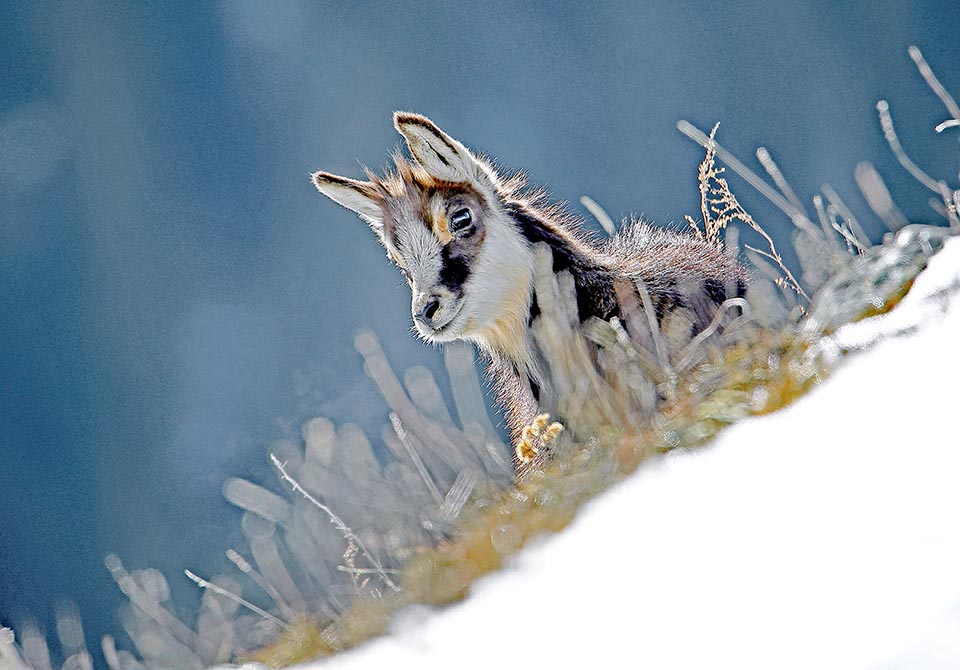
Puppy observing the feats. Deliveries, rarely twins, take place in May and the newborn after a few hours is capable to follow the mother © Pourtallier Philippe
In particular, the most significant occurrences are reported in the French, Italian, Swiss, Austrian and Bavarian Alps, in Liechtenstein, along the Jura Mountains, in Slovenia and in the Balkans. At the beginning of the twentieth century, for hunting purposes, it was introduced in New Zealand, where it has naturalized and has reached the 100.000 individuals.
In Italy, it is more or less evenly diffused along the whole alpine arc with bigger concentrations in the provinces of Trento, Bolzano and Verona (Veronese Pre-Alps) and in Piemonte, region where is estimated the presence of the 62% of the Italian Alpine chamois. Southwards, the limit of the range stands in Liguria, up to the province of Imperia, with some rare sightings in the province of Savona.
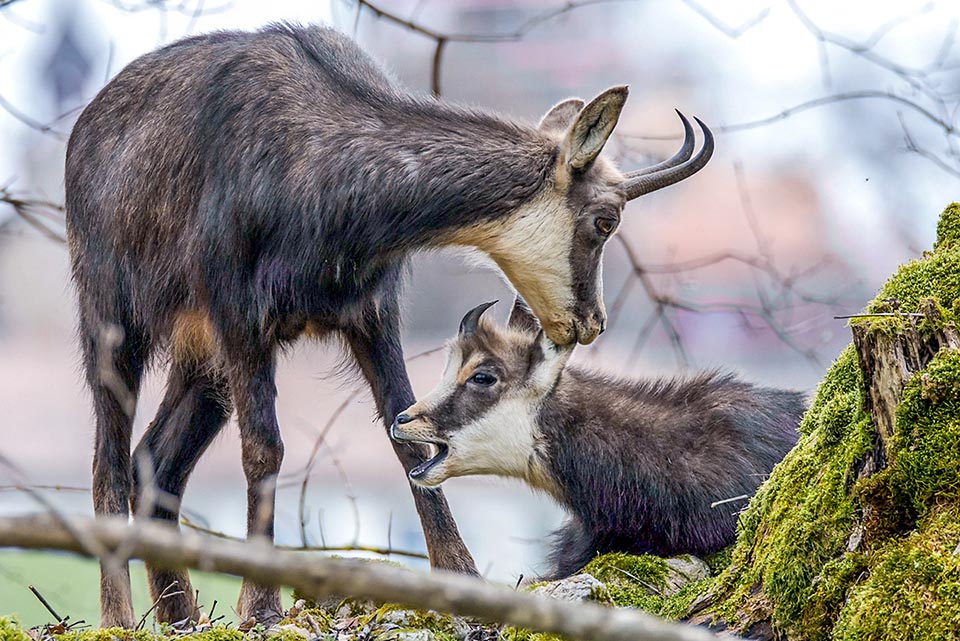
At once a special relationship begins and will last until the following pregnancy © Enrico Petraglio
The population is presently considered as stable by IUCN, consequently evaluated and inserted in the Red List of Threatened Species as LC-Least Concern species.
The hunting activity concerning this species is ruled, in Italy, from 1992 and it can be hunted only after the rules of selection hunting of the ungulates.
Ecology-Habitat
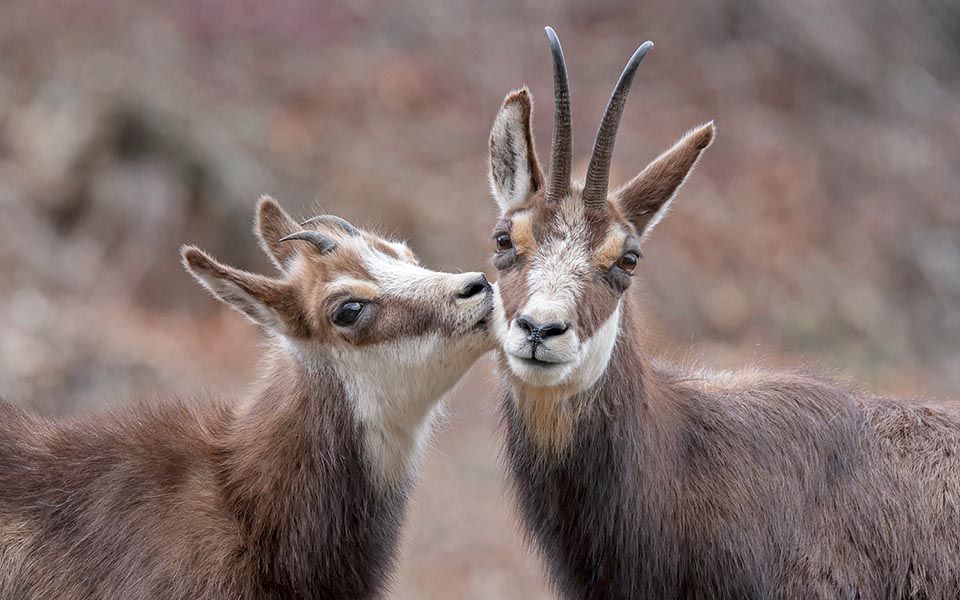
This one, now big, still needs tenderness © Enrico Petraglio
The Alpine chamois habitat may vary depending on the season and on the snow cover and extends over three altitudinal lines: the mountain one, characterized by conifers and broad leaved trees rich of undergrowth, interspersed with rocky walls, gorges and clearing; the sub-alpine line with scattered larches, mountain pine thickets and brush woods; the alpine line marked by prairies, dwarf shrubs and rocky zones, up to the snow horizon line (2600-3000 m) and the upper limit of the perennial vegetation.
In the warmest months and with no snow cover, the Alpine chamois tends to frequent mainly high-altitude grasslands and grassy slopes, areas characterized by the availability of a rich variety of vegetable species with different grades of ripening and finds shelter in woody areas in case of too high temperatures.
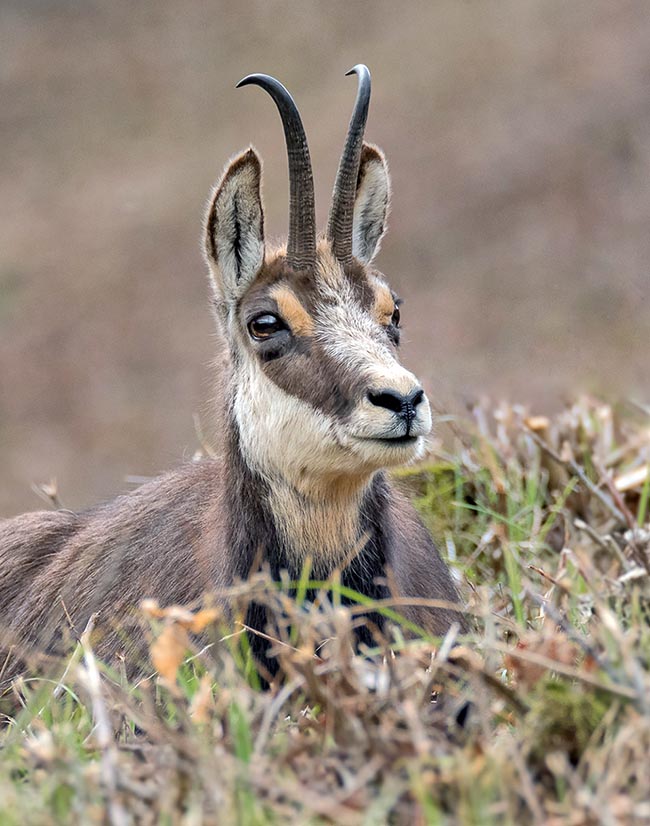
To know the age of a chamois it’s sufficient to count the rings of the horns forming every year in spring-summer © Enrico Petraglio
During the last period of pregnancy, that is around the month of May, the pregnant females get away from the rest of the flock to reach rocky slopes and very steep walls, in order to get ready for the moment of delivery in sites hardly accessible by any predators.
In the winter months, with the arrival of the first snowfalls, the Alpine chamois tends to descend in altitude and to prefer slopes and uneven walls that do not allow the snow to accumulate too much and to cover all the available vegetation.
In these dynamics it is evident the strong link of this species with the rocky element that, for reasons related to food and possibility of escape, becomes decisive in the choice of the range.
Morphophysiology
The Alpine chamois is a medium sized bovid, with a length varying from 110 and 140 cm and an average height of about 80 cm at the withers, that is the zone corresponding to the first dorsal vertebrae.
The sexual dimorphism stands in a larger size in the male and a slenderer body in the female.
The weight of this animal goes from a minimum of 25 kg in the females to a maximum of 40-45 kg in the males; it is very variable during the year and reaches a top in the months of October-November due to the accumulation of fat aimed at guaranteeing an energy reserve during the cold season, whilst the minimum weight, in the males; is reached by the end of the reproductive period due to the high energetic cost caused by the struggles for the conquest of the female.
Also the fur is subject to a remarkable seasonal variation and it performs two moultings, one in autumn and the other in spring.
During the cold months the hair is darker, thus, to guarantee a greater absorption of the sun’s rays, and thicker to allow an effective thermal insulation. In this period is much more marked the dark facial mask characterizing the snout and extending from the base of the horns up to the nose covering the eyes. The rest of the head, the belly and the anal mirror are the only zones to appear clearer.
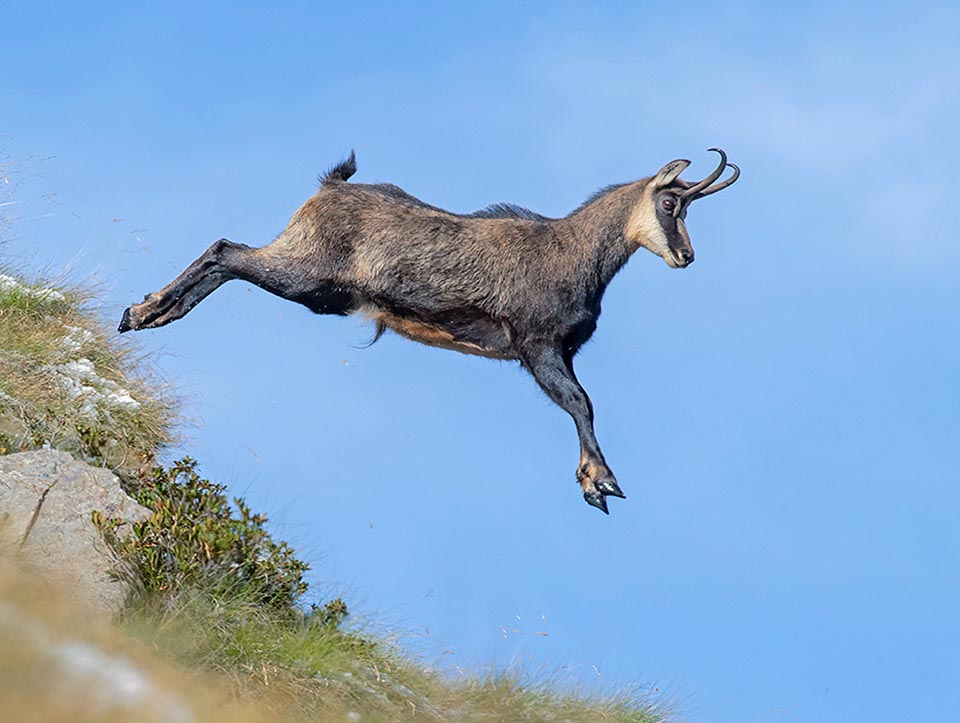
The agility with which moves between rocks allows a rapid and reckless escape with incredible jumps in case of danger © Emilio Ricci
Around the month of March, the winter fur begins slowly to be replaced by the summer one characterized by shorter and more bristly hair and by brown-reddish shades. Keep dark the legs and a median stripe on the back, in correspondence to the vertebral column.
The most peculiar and distinctive character of this species is represented by the horns, different from those of the other bovids. These are black and rise vertically forming at the extremities a hook facing backwards; they have an average length of 20-25 cm and are present in both sexes with minimal differences such as, in the male, a slightly higher diametre at the base and lower hook inclination angle.
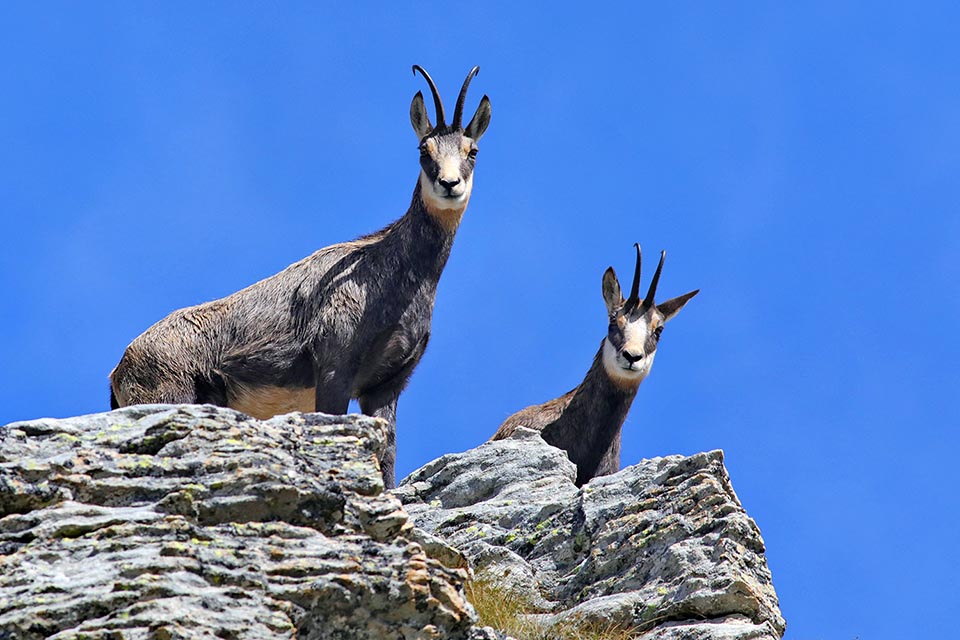
View from above stimulates curiosity and allows an ample control of all surrounding area © Philippe Pourtallier
These begin to grow since birth and in a faster way during the first three years of life. The horn is formed by a covering of keratin that covers a bony protuberance. The growth takes place in spring-summer whilst in winter it interrupts during the so-called “cornual pause” and the alternation of these two phases determines the formation of growth rings from which is possible to estimate the age of the animal.
Behind the horns are located special glands appointed to mark the territory and the substance released, in the males, takes on a very strong smell during the mating period, with the aim of attracting and stimulating the female for the mating; for such reason these are called “glands of the fregola” or “love glands”.
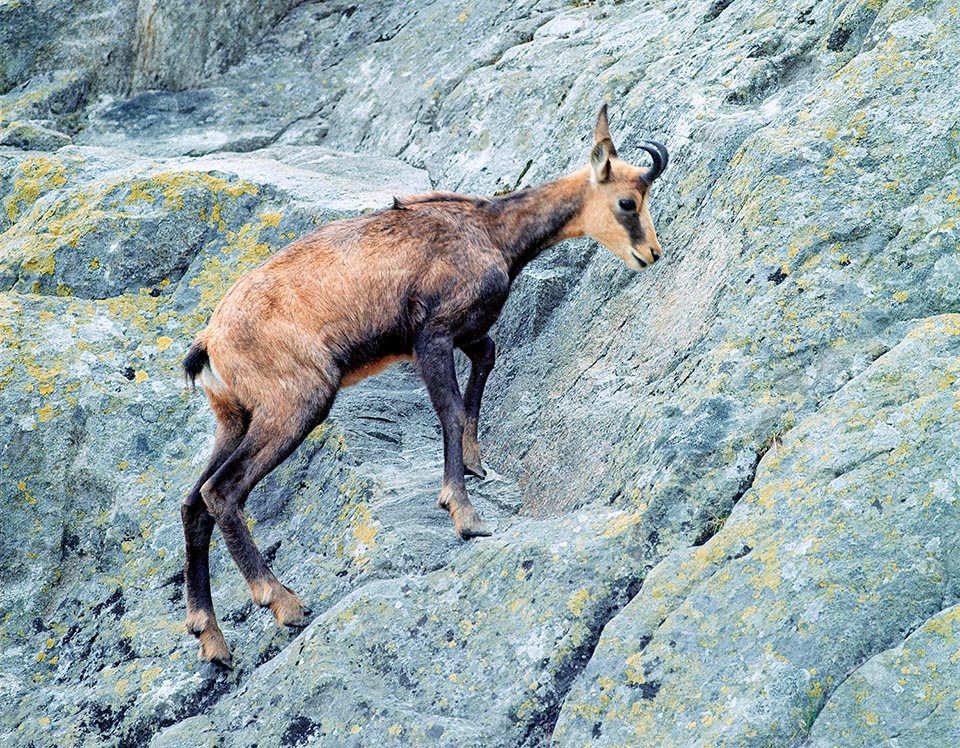
Various adaptations favour the link with the mountain environment. The hoof with sharp edges allows a solid grip even on small protuberances and almost vertical walls © Giuseppe Mazza
The inseparable link of this animal with the mountain environment is favoured by particular physiological and morphological adaptations, like, for instance, the structure of the hoof with the sharp edges that allow the grip even on the smallest protrusions and on the ice to which adds an interdigital membrane that allows an agile pace even on the fresh now.
Due to the lower oxygen pressure present at high altitudes, more efficient lungs, big heart and high number of red blood cells ensure, in the Alpine chamois, an adequate blood oxygenation.
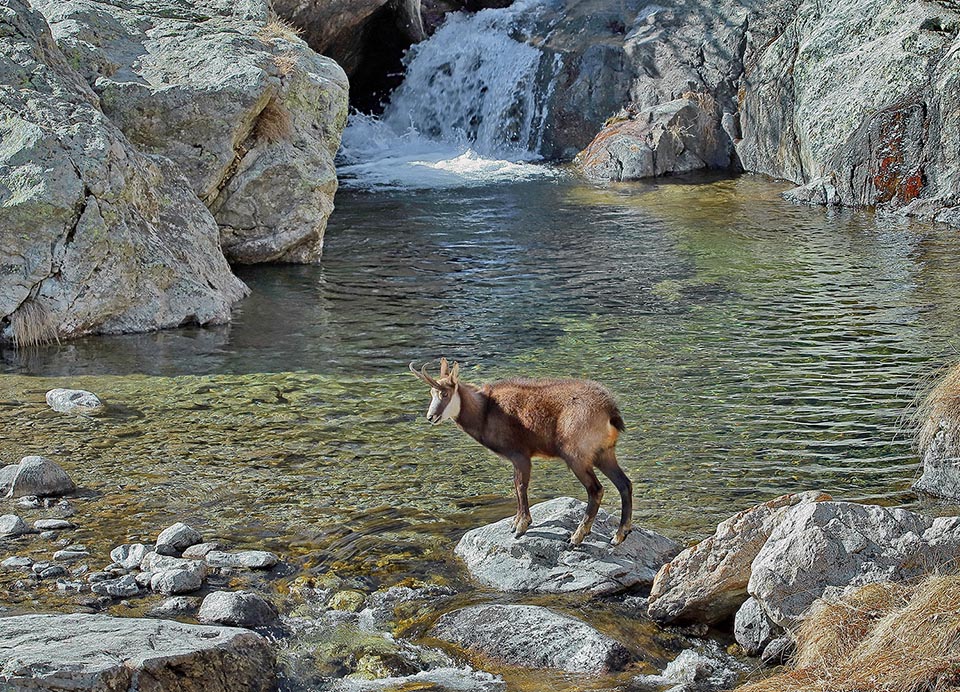
If without water the chamois hydrates through dew, but if the availability is big why not to take advantage of it? © Philippe Pourtallier
The Alpine chamois belongs to the suborder of the Ruminants, animals whose stomach is subdivided in four chambers and that practice the “rumination”: they ingest big quantities of food and then, calmly, regurgitate it inside the buccal cavity, chew it again and then digest it definitively.
This behaviour is typical of many herbivorous species and is considered an evolutionary adaptation intended to minimize the time of exposure to possible predatory attacks guaranteeing however the ingestion of adequate quantities of food, that later will be calmly digested during the following grazing moments.
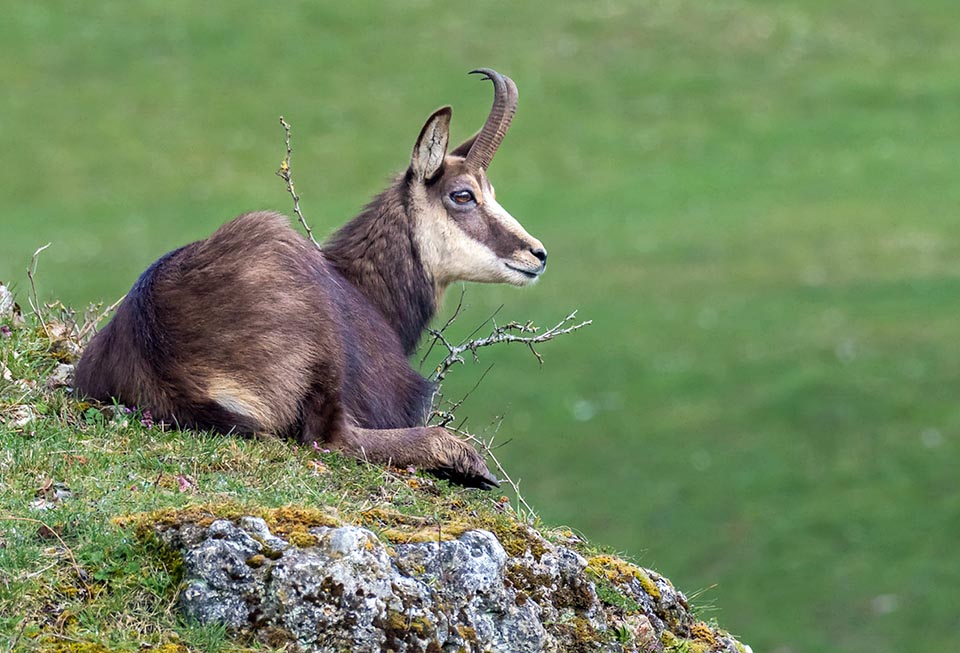
Adult males live solitary most of year, frequenting vast areas at lower altitudes than females. However, in the reproductive period, between November and December, they reach the herd and delimit a territory with strong odorous secretion of glands located close to the horns, to attract the females and chase away any rivals © Enrico Petraglio
The distribution of this species is strictly related to its feeding necessities; it is an intermediate grazer that selects, depending on the seasonal availability, the species as well as the part of the plant to consume. In spring, its diet is formed mainly of buds and inflorescences of gramineous plants ad, with the arrival of summer, period of greatest vegetal luxuriance, tends to integrate several herbaceous species such as, for instance, the Trifolium alpinum; in this period, we note also an increment of the quantity of food ingested with the purpose of storing energetic reserves in view of the cold season.
In fact, in winter, the Alpine chamois must be content with lichens, mosses, dry grasses and some bud of conifer that manages to locate digging in the snow.
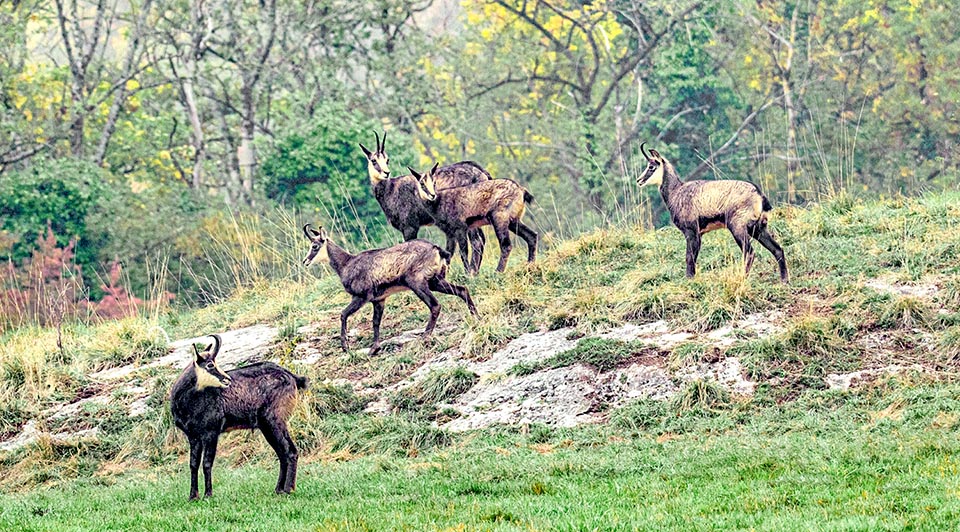
Every individual survey the herd. In case of threat, it emits an acute and long whistle that puts everyone on alert. Then an orderly escape follows © Norbert Bosset
Finally, the water is assumed through the dew or taking advantage of some source.
Ethology-Reproductive Biology
The Alpine chamois are gregarious animals, but this mainly concerns the females.
They live in groups of 15-30 individuals, formed also by the small young and by some 2 or 3 years old young, led by the oldest and most experienced females. Therefore, we are in the presence of a social structure of matriarchal type.
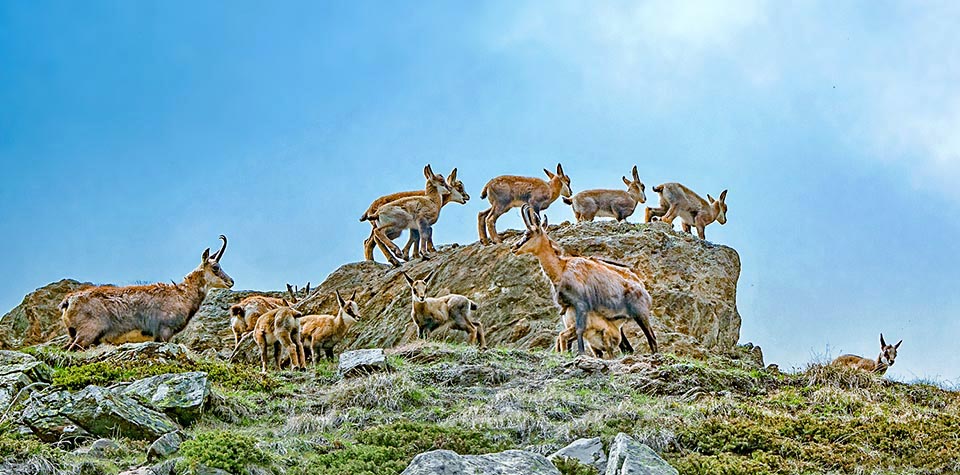
The females of Rupicapra rupicapra live in groups of 15-30 units, composed also by the kids and by some 2 or 3 years old young led by the older and experienced females. We can then talk, apart the reproductive time, with even violent fights between males that act as masters, of a social structure of matriarchal type © Roberto Vallet
The advantages of this collective behaviour stand surely in the protection the group offers to the single individual in case of a possible danger of predation.
Hence, each individual contributes in surveying the herd and, if it senses a threat, it emits an acute and long whistle alarming everyone.
If the danger is important, the alarm is followed by the escape: at the head there will be a guide, the kids stay behind their mothers and the young at the end of the group as rearguard.
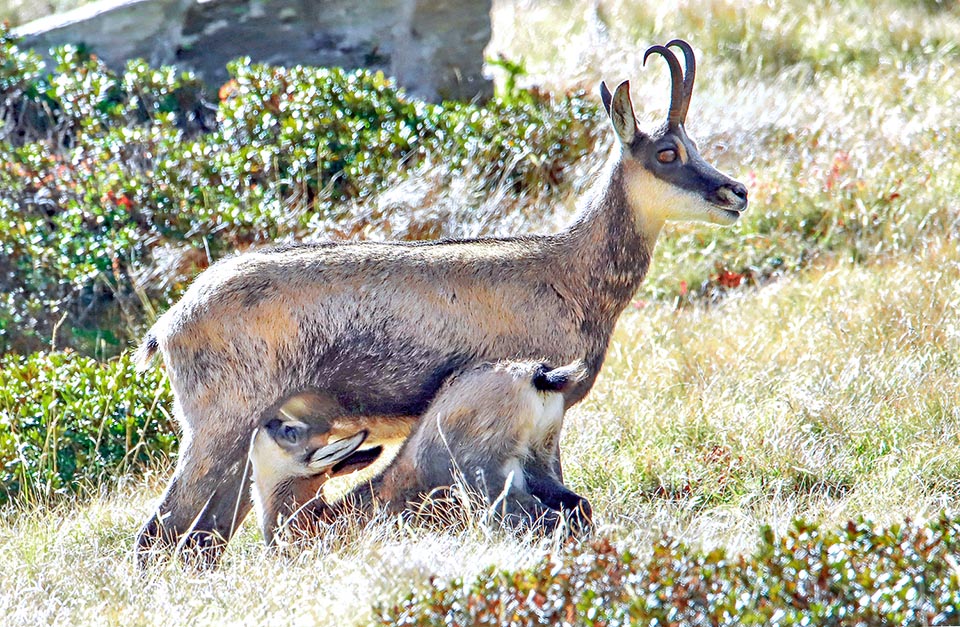
Pregnancy lasts 160-170 days and culminates in late May and early June. Breastfeeding lasts for about six months © Philippe Pourtallier
The adult males are usually solitary for most of the year, whilst they join the herd during the reproductive period, that is between November and December.
During this time the most mature males tend to send away the young and to assume a territorial attitude: they try to keep the females inside a certain area defined and marked rubbing the horns on shrubs and rocks; almost always this behaviour is sufficient to hold the other males far away, but, if this is not the case, especially if there is a territorial overlapping between two adult males having the same age and having a similar hierarchical degree, they reach the physical confrontation.
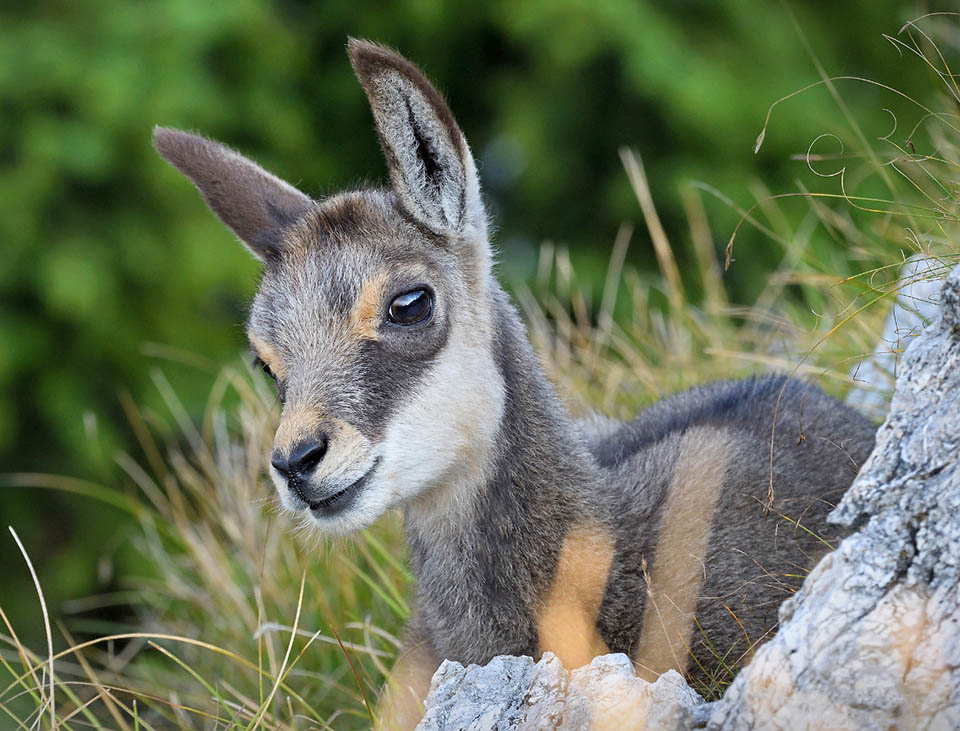
A recently born puppy who has not yet the horns © Silvia Busato
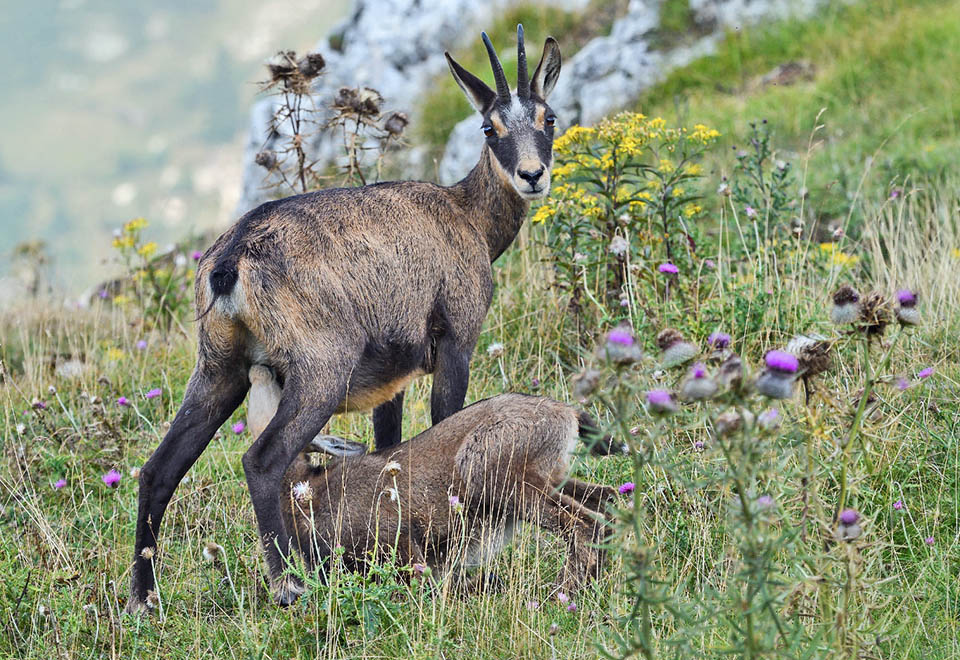
There is milk for him too, in the dramatic flowery landscape of the alpine pastures © Silvia Busato
If the mating is successful, follows a pregnancy lasting 160-170 days and that culminates between the end of May and the beginning of June, when the mothers usually give birth to only one kid, but occasionally may occur even twins births.
Upon birth the weight is of about 2 kilograms and the kid presents already completely developed and with open eyes. Usually deliveries occur in synchrony, and, after a few days, the females unite and form groups of mothers and newborns.
In the alpine pastures they find the resources necessary to provide a rich and substantial breastfeeding that is carried forward for about the first six months.
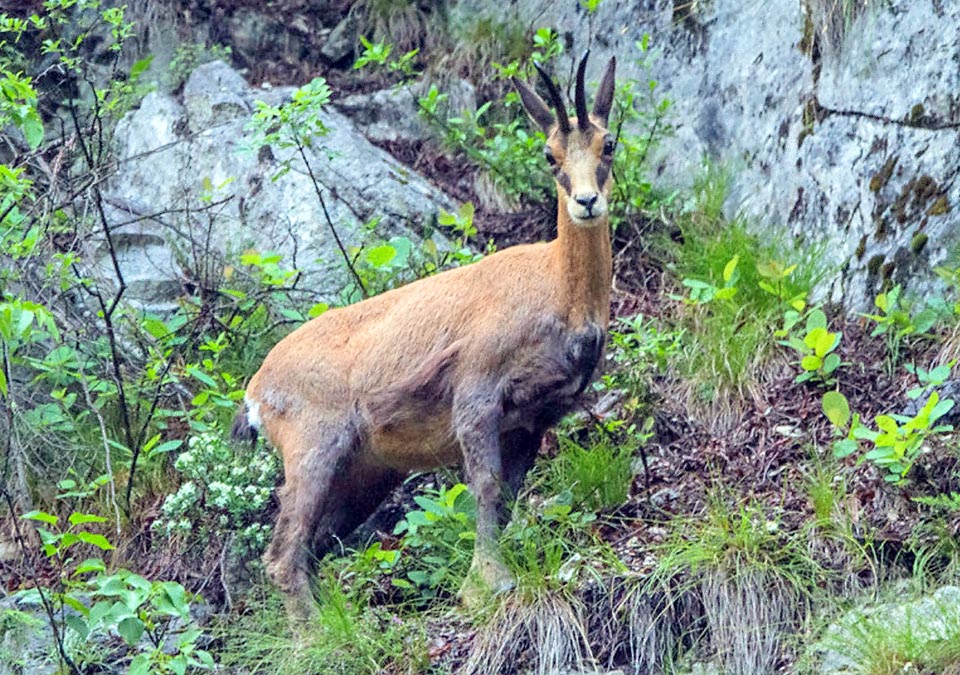
The subspecies Rupicapra rupicapra balcanica distinguishes for the longer horns and the fur colour: more brownish in summer and dark with yellowish shades in winter © Boris Belchev
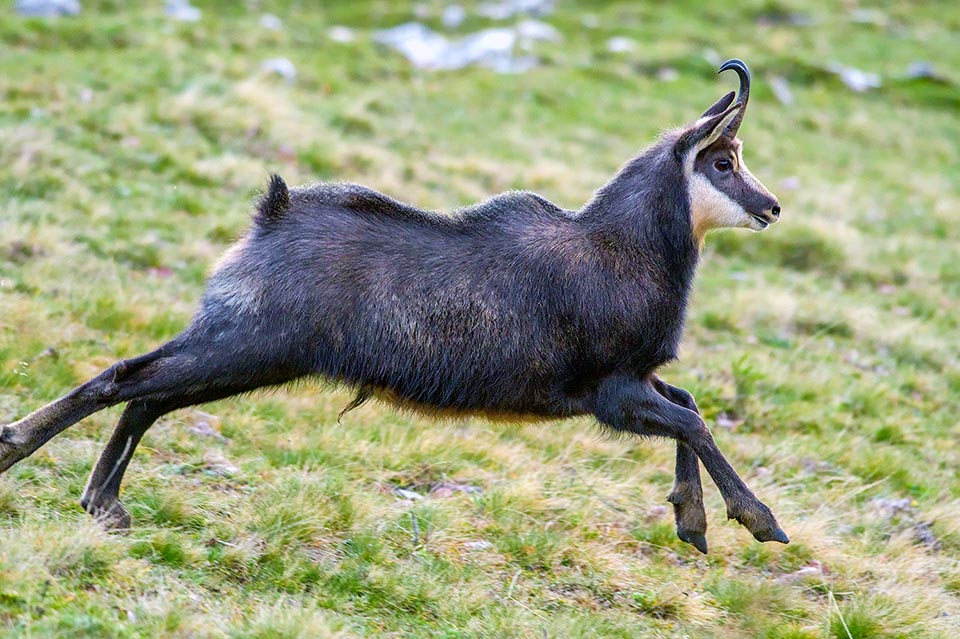
The Rupicapra rupicapra cartusiana is bigger than the average and the winter fur tends to black © Ollivier Daeye
After delivery is immediately established a special relationship between mother and kid, who, after a few hours, is already in condition to follow her; this link will last for about one year, until the following mating when it will be sent away. Should the mother, for any reason, pass away, the other females of the group will take charge of the less than one year old kid.
Among the most common natural predators of the Alpine chamois we find the fox, the wolf and birds of prey such as the Golden eagle.
(Aquila chrysaetos) and the Gypaetus or Bearded vulture (Gypaetus barbatus). These take advantage of the inexperience of the kids and attack them when they are crossing the rocky walls trying to make them fall into the void. The firstwill eat the flesh and the second the bones.
Synonyms
Rupicapra tragus Gray, 1843; Capra rupicapra Linnaeus, 1758; Antilope rupicapra (Linnaeus, 1758).
→ For general information about ARTIODACTYLA please click here.
